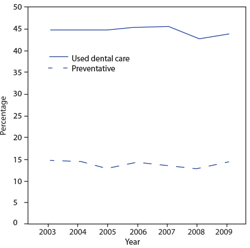CDC report on preventive services
BY CHRISTINE NATHE, RDH, MS
A new report on dental health was recently published with more good news for dental hygiene. Truly, the number of reports discussing dental health published since 2010 have been remarkable. This specific report was published by the Center for Disease Control and Prevention (CDC). The CDC not only focuses on prevention of communicable diseases as seen in the news, but the federal agency also works on oral health and disease surveillance and intervention.
The published dental health report is part of a larger publication on preventive clinical services. The report focuses on the use of preventive dental services from 1999-2011 and is titled, "Use of Dental Care and Effective Preventive Services in Preventing Tooth Decay Among U.S. Children and Adolescents - Medical Expenditure Panel Survey, United States, 2003-2009 and National Health and Nutrition Examination Survey, United States, 2005-2010."
The report used data from national surveys to examine dental utilization rates historically, as well as the use of fluoride applications and dental sealants. The report specifically focused on infants, children, and adolescents.
Data from existing research reports helped describe the oral health status, preventive dental service usage, and resources in this pediatric population. The related sidebar, "Data from CDC report," highlights the information contained within the CDC report.
Particularly disheartening is the low number of children using dental services, specifically, using preventive dental services (see Figure 1).
These data spotlight the dental needs of many children in society. Additionally, emphasis should be placed on the fact that many children are not receiving necessary dental services, particularly preventive services. Prevention would enhance overall health and well-being, and simultaneously, decrease long term cost of dental care in society. It is important for dental hygienists to use this data, when striving for policies that ensure oral health care for all! RDH
Data from CDC report
Dental Decay
• Approximately 23% of children aged 2-11 years have at least one primary tooth with untreated decay and 20% of adolescents aged 12-19 years have at least one permanent tooth with untreated decay.
• Risk factors for tooth decay include recent history of cavities, low fluoride exposure, and living in a low-income household.
• Prevalence of untreated decay in primary or permanent teeth among children from lower-income households is more than twice that among children from higher-income households.
• Prevalence of untreated tooth decay is also higher among Mexican-American children and non-Hispanic black children than among white non-Hispanic children.
• By age 15, approximately 60% of all adolescents will have experienced tooth decay.
• An estimated 51.7 million school hours are missed annually by school-aged children because of a dental problem or visit.
Financing Dental Care
• In 2009, the total dental expenses for U.S. children aged 5-17 years were approximately $20 billion, accounting for 17.7% of all health-care expenses among this age group.
• Approximately 40% of dental costs were paid out of pocket, compared with 17% for medical care.
• Approximately one fourth of U.S. children do not have dental insurance (private or public).
• The types of services covered by dental insurance vary widely by plan, but typically have higher copayments and lower annual limits than services covered by medical insurance.
Dental Usage
• Less than half of children aged under 21 years (43.8%) used dental care in 2009 and only 14.2% of children aged under 21 years received a preventive dental service (such as topical fluoride, sealants, or both)
• Lower likelihood of dental care and preventive care was associated with being a non-Hispanic black or Hispanic child, having lower family income, head of household having lower educational attainment, and not having medical insurance.
• Children with private dental insurance were more likely to receive preventive care than were children without private dental insurance.
• Neither dental sealant prevalence nor dental use varied by disability status.
Source: Centers for Disease Control and Prevention, 2014
CHRISTINE NATHE, RDH, MS, is director at the University of New Mexico, Division of Dental Hygiene, in Albuquerque, N.M. She is also the author of "Dental Public Health Research" (www.pearsonhighered.com/educator), which is in its third edition with Pearson. She can be reached at [email protected] or (505) 272-8147.
References
1. Griffin, SO, Barker, LK, Wei, L,Chien-Hsun, L, Albuquerque, MS, Gooch, BF. Use of Dental Care and Effective Preventive Services in Preventing Tooth Decay Among U.S. Children and Adolescents - Medical Expenditure Panel Survey, United States, 2003-2009 and National Health and Nutrition Examination Survey, United States, 2005-2010. MMWR. Supplements September 12, 2014 / 63(02);54-60
2. To read the entire report and use the research data cited in the report, please see http://www.cdc.gov/mmwr/preview/mmwrhtml/su6302a9.htm?s_cid=su6302a9_w

